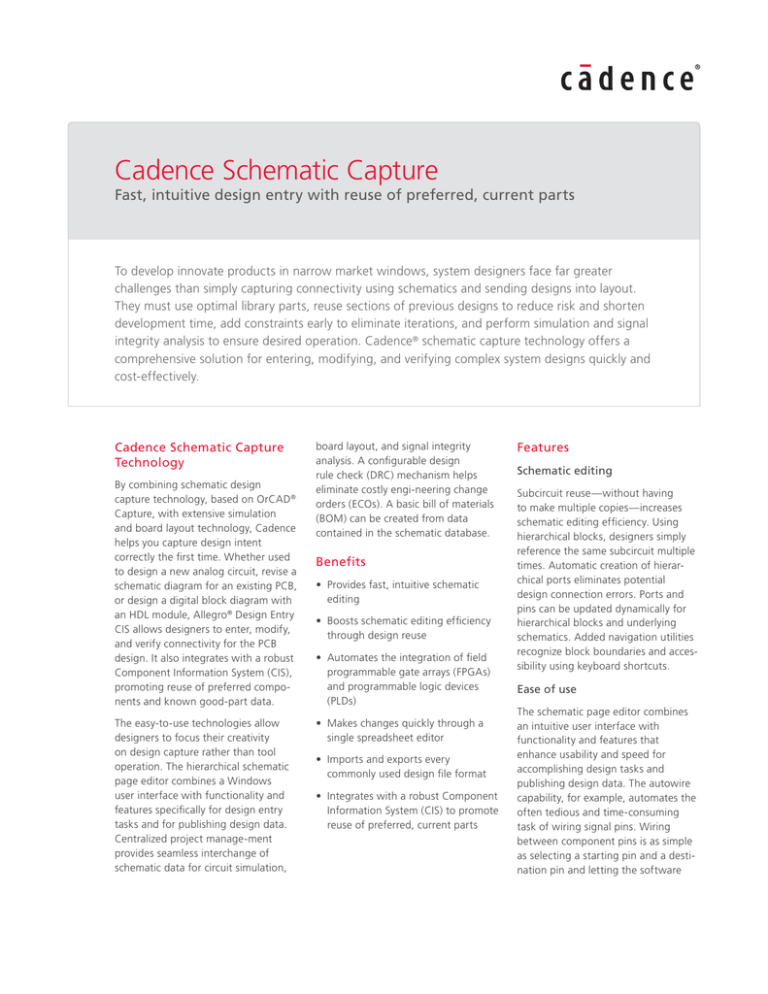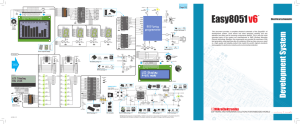
Cadence Schematic Capture
Fast, intuitive design entry with reuse of preferred, current parts
To develop innovate products in narrow market windows, system designers face far greater
challenges than simply capturing connectivity using schematics and sending designs into layout.
They must use optimal library parts, reuse sections of previous designs to reduce risk and shorten
development time, add constraints early to eliminate iterations, and perform simulation and signal
integrity analysis to ensure desired operation. Cadence® schematic capture technology offers a
comprehensive solution for entering, modifying, and verifying complex system designs quickly and
cost-effectively.
Cadence Schematic Capture
Technology
By combining schematic design
capture technology, based on OrCAD®
Capture, with extensive simulation
and board layout technology, Cadence
helps you capture design intent
correctly the first time. Whether used
to design a new analog circuit, revise a
schematic diagram for an existing PCB,
or design a digital block diagram with
an HDL module, Allegro ® Design Entry
CIS allows designers to enter, modify,
and verify connectivity for the PCB
design. It also integrates with a robust
Component Information System (CIS),
promoting reuse of preferred components and known good-part data.
The easy-to-use technologies allow
designers to focus their creativity
on design capture rather than tool
operation. The hierarchical schematic
page editor combines a Windows
user interface with functionality and
features specifically for design entry
tasks and for publishing design data.
Centralized project manage-ment
provides seamless interchange of
schematic data for circuit simulation,
board layout, and signal integrity
analysis. A configurable design
rule check (DRC) mechanism helps
eliminate costly engi-neering change
orders (ECOs). A basic bill of materials
(BOM) can be created from data
contained in the schematic database.
Benefits
• Provides fast, intuitive schematic
editing
• Boosts schematic editing efficiency
through design reuse
• Automates the integration of field
programmable gate arrays (FPGAs)
and programmable logic devices
(PLDs)
• Makes changes quickly through a
single spreadsheet editor
• Imports and exports every
commonly used design file format
• Integrates with a robust Component
Information System (CIS) to promote
reuse of preferred, current parts
Features
Schematic editing
Subcircuit reuse—without having
to make multiple copies—increases
schematic editing efficiency. Using
hierarchical blocks, designers simply
reference the same subcircuit multiple
times. Automatic creation of hierarchical ports eliminates potential
design connection errors. Ports and
pins can be updated dynamically for
hierarchical blocks and underlying
schematics. Added navigation utilities
recognize block boundaries and accessibility using keyboard shortcuts.
Ease of use
The schematic page editor combines
an intuitive user interface with
functionality and features that
enhance usability and speed for
accomplishing design tasks and
publishing design data. The autowire
capability, for example, automates the
often tedious and time-consuming
task of wiring signal pins. Wiring
between component pins is as simple
as selecting a starting pin and a destination pin and letting the software
Cadence Schematic Capture
add the connection —all automatically
and quickly. Context-sensitive menus,
OLE support, custom colorization of
wires/nets/parts, and a tabbed/dockable
interface all provide a better user
experience.
Project
Manager
Schematic
Editor
Project management
The project manager (see Figure 1)
enables users to collect and organize
all the resources needed for the project
throughout the design flow. The
expanding tree structure makes it easy
to organize and navigate design files,
including those generated by Cadence
PSpice ® and Allegro AMS Simulators,
OrCAD Capture CIS, Allegro Design
Entry CIS, and other plugins. The project
manager offers easy navigation of design
files. It also includes a wizard to guide
users for specific design flows and a
hierarchy viewer to display hierarchical
relationships among design modules.
Property
Editor
Figure 1: The multi-window interface of Cadence schematic capture technology simplifies
navigation and searches across the hierarchy
Hierarchical design and reuse
Easy data entry
The full-featured schematic editor (see
Figure 1) enables users to place and
connect parts from a comprehensive
set of functional libraries. It uniquely
packages the parts, ensures design
integrity, and creates design netlists
for any of the formats supported by
Cadence. Users can view and edit
multiple schematic designs in a single
session, and copy and paste design data
between schematics, enabling data reuse.
The schematic editor also supports the
addition of critical constraints for a design
editing to PCB editing flow.
Designers can access all part, net, pin,
and title block properties or any subset
and make changes quickly through
the spread-sheet property editor (see
Figure 1). It simply requires selecting a
circuit element, a grouped area, or an
entire page, and then editing part, net, or
pin properties.
Libraries and part editing
The library editor is accessed directly
from the user interface. Users can create
and edit parts in the library or directly
from the schematic page without interrupting workflow. Intuitive graphical
controls speed schematic part creation
and editing. New parts can be created
quickly by modifying existing ones. New
parts can also be created from spreadsheets. A library part generator automates
the integration of FPGAs and PLDs into
the system schematic. The generate part
feature simplifies the creation of core
FPGA library parts for high pin-count
devices. These parts can be split into
multiple parts.
www.cadence.com
Component information system
Allegro Design Entry CIS and OrCAD
Capture CIS integrate the features of a
Component Information System (CIS) with
Cadence schematic capture technology.
The products are designed to reduce
production delays and cost overruns
through efficient management of components. The time spent searching existing
parts for reuse, manually entering part
information content, and maintaining
component data is reduced. Users search
for parts based on their electrical characteristics and CIS automatically retrieves
the associated part (see Figure 2).
CIS is ideal for individual design teams
or teams who need to collaborate across
multiple locations. It gives designers
access to correct part data early in the
design process and enables complete
component specifications to be passed to
board designers and other members of
the design team, reducing the chances for
downstream errors. It also provides access
to cost information so designers can use
preferred, lower-cost, and in-stock parts.
The embedded part selector accesses
information stored in MRP or ERP systems
and engineering databases, and it
synchronizes externally sourced data with
the schematic design database so BOMs
can be generated automatically
Relational data support
CIS allows for the creation and usage of
relational tables in the component parts
database. These relational tables have
a one-to-many relationship with the
part information (primary) tables. The
relational database may contain a vendor
table with multiple vendor/manufacture
part numbers for a single company part
number in the electrical (e.g. resistor)
table. With this structure, search and
query for data across the primary and
relational tables is possible.
Extended CIS documentation
CIS also provides powerful report generation. Instead of limiting designers to
just those properties that reside in the
schematic, CIS draws from the extensive
wealth of information that resides in the
preferred part database, taking report
generation to the next level. Designers
2
Cadence Schematic Capture
can generate BOMs using up-to-date,
comprehensive, and complete information, and create reports through the
Crystal report engine.
CIS
Explorer
Architecture/database integration
• Accepts plug-ins for programmable
logic design and analog simulation
• Allows for design creation and
simulation in the same environment
• Works with Microsoft’s
ODBC-compliant databases
• Users can access data directly in an
MRP, ERP, and PDM system
Documentation
Cadence technology provides an extensive
set of documentation, which includes
user guides, context-sensitive help (F1),
reference guides, online tutorials, and
multimedia demonstrations.
The documentation set helps you to:
• Find the answer you need by searching
the online help system and navigate
quickly between related topics with
extensive hypertext cross-references
• Learn the technology with the help of
online interactive tutorials
• Find information on error and warning
scenarios
FPGA
Allegro Design Entry CIS, together with
Allegro FPGA System Planner, addresses
the challenges that engineers encounter
when designing large pin-count FPGAs on
the PCB board—which includes creating
the initial pin assignment, integrating
with the schematic, and ensuring that
the device is routable on the board. They
deliver a complete, scalable technology
for FPGA-PCB design-in and co-design
that automates creation of optimum
“device-rules-accurate” pin assignment,
symbol creation, and flow. By replacing
manual, error-prone processes with
automatic pin assignment synthesis, this
unique placement-aware solution eliminates unnecessary physical design iterations while shortening the time required
to create optimum pin assignment.
www.cadence.com
Figure 2: Visibility into complete part information ensures informed part selection, reducing the risk
of delays later in the design process
Design-in
Allegro Design Entry CIS supports the
FPGA design flow with the ability to
quickly import and/or create FPGA
symbols and components. With an everincreasing pin count and complexity for
FPGA parts, the easy-to-use GUI-based
options of Design Entry CIS can be used
to create single and multi-section FPGA
parts based on the device I/O pin files.
Support for split parts, power pin visibility,
pin shape, and pin group management
provide flexibility to tailor symbol creation
to the design needs. FPGA components
can also be exported using the export
FPGA dialog box. The export FPGA
function completes the bi-directional
link between FPGA designers and PCB
designers.
that accounts for FPGA placement on the
PCB (placement-aware pin assignment
synthesis). This unique placement-aware
pin assignment approach eliminates
unnecessary physical design iterations
that are inherent in manual approaches.
Allegro FPGA System Planner is integrated
with both Design Entry CIS and
Allegro PCB Editor. It reads and creates
schematics and symbols. In addition, a
floorplan view uses existing footprint
libraries from Allegro PCB Editor. Should
placement change during layout, pin
optimization using FPGA System Planner
can be accessed directly from Allegro PCB
Editor.
Specifications
System requirements
Co-design
• Pentium 4 (32-bit) equivalent or faster
Allegro FPGA System Planner provides a
complete, scalable solution for FPGA-PCB
co-design that allows users to create
an optimum correct-by-construction
pin assignment. FPGA pin assignment
is synthesized automatically based on
user-specified, interface-based connectivity (design intent), as well as FPGA
pin assignment rules (FPGA rules), and
actual placement of FPGAs on PCB
(relative placement). With automatic pin
assignment synthesis, users avoid manual
error-prone processes while shortening
the time to create initial pin assignment
• Windows XP Professional, Vista
Enterprise
• Minimum 512MB (1G or more
recommended for XP and Vista
Enterprise requirements)
• 300MB swap space (or more)
• DVD-ROM drive
• 65,000 color Windows display with
minimum 1024 x 768 (1280 x 1024
recommended)
3
Cadence Schematic Capture
Cadence Services and Support
• Cadence application engineers can
answer your technical questions by
telephone, email, or Internet—they can
also provide technical assistance and
custom training
• Cadence certified instructors teach
more than 70 courses and bring
their real-world experience into the
classroom
• More than 25 Internet Learning Series
(iLS) online courses allow you the
flexibility of training at your own
computer via the Internet
• Cadence Online Support gives you
24x7 online access to a knowledgebase
of the latest solutions, technical
documentation, software downloads,
and more
Cadence is transforming the global electronics industry through a vision called EDA360.
With an application-driven approach to design, our software, hardware, IP, and services help
customers realize silicon, SoCs, and complete systems efficiently and profitably. www.cadence.com
© 2011 Cadence Design Systems, Inc. All rights reserved. Cadence, the Cadence logo, Allegro, OrCAD, and PSpice are registered trademarks of
Cadence Design Systems, Inc. All others are properties of their respective holders.
21420 11/11 MK/DM/PDF


